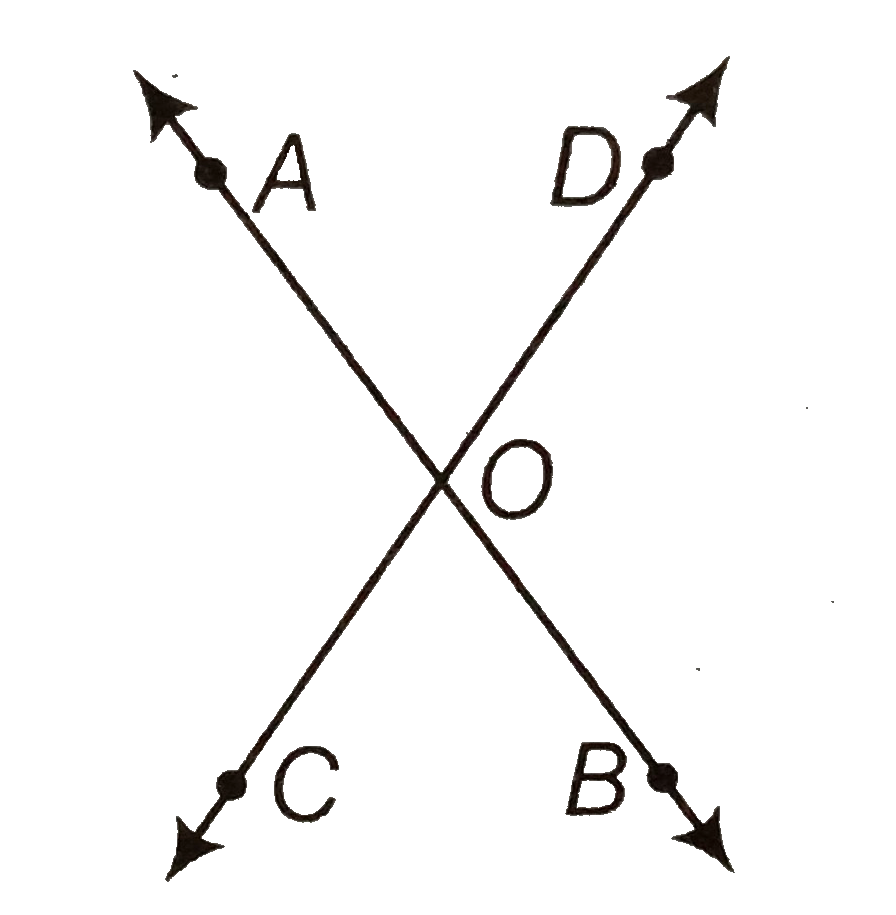If two lines intersect prove that the vertically opposite angles are equal
Given Two lines AB and CD intersect at point O.
To prove
(i) ∠AOC=∠AOD
(ii) ∠AOD=∠BOC Proof
(i) Since, ray OA stands on line CD
∴ ∠AOC=∠AOD=180∘ [linear pair axiom].....(i)
Since, ray OD stands on line AB
∴ ∠AOC=∠AOD=180∘ [linear pair axiom].....(ii)

From Eqs. (i) and (ii),
∠AOC+∠AOD=∠AOD+∠BOD
⇒ ∠AOC=∠BOD
(ii) Since, ray OD stands on line AB
∴ ∠AOD+∠BOD=180∘ [linear pair axiom].....(iii)
Since. ray OB stand on line CD.
∴ ∠DOB+∠BOD=180∘ ....(iv)
From Eqs. (iii) and (iv),
∠AOD=∠BOD=∠DOB+∠BOC
⇒ ∠AOD+∠BOC Hence proved.
Topper's Solved these Questions
Similar Questions
Prove that vertically opposite angles are equal.
View SolutionStatements a and b are as given below:
a : If two lines intersect, then the vertically opposite angles are equal.
b : If a transversal intersects, two other lines, then the sum of two interior angles on the same side of the transversal is 180∘.
Then
View Solution
Knowledge Check
Students are asked to establish a relation between vertically opposite angles. They draw various figures, measure the angles and observe that vertically opposite angles are equal.
In this case, students according to Van Hecle thought are atADeduction levelBVisualization levelCAnalytic levelDInformal Deduction level
If two lines intersect; then the vertically opposite angles are equal.
View SolutionProve that if two lines intersect each other, then the vertically opposite angles are equal.
View SolutionIf two lines intersect each other, then the vertically opposite angles are equal.
View SolutionTheorem 6.1 : If two lines intersect each other, then the vertically opposite angles are equal.
View SolutionVertically opposite angles are always
View SolutionRead the following two statements which are taken as axiom:
(i) If two lines intersect each other , then the vertically opposite angles are not equal.
(ii) If a ray stands on a line , then the sum of two adjacent angles, so formed is equal to 180∘.
Is this system of axioms consistent ? Justify your answer.
View SolutionFill in the blanks:(i) If two angles are complementary, then the sum of their measures is _______.(ii) If two angles are supplementary, then the sum of their measures is ______.(iii) Two angles forming a linear pair are _______________.(iv) If two adjacent angles are supplementary, they form a ___________.(v) If two lines intersect at a point, then the vertically opposite angles are always_____________.(vi) If two lines intersect at a point, and if one pair of vertically opposite angles areacute angles, then the other pair of vertically opposite angles are __________.
View Solution
